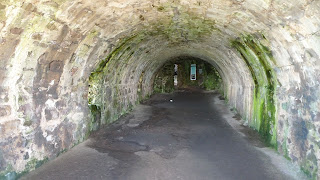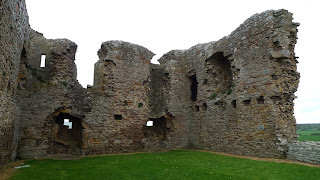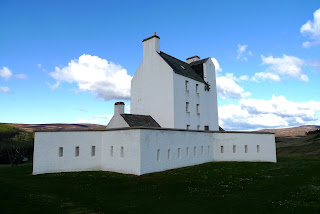I have trans friends to whom I feel very loyal, and so I wasn't really going to stay away from the big summer event for Brighton trans people. In fact I was there for three hours or so, and enjoyed myself - at least up to the point where I started to go deaf from taking pictures too close to one of the the stage loudspeakers. But in essence I was a casual visitor, dropping in for hellos and photography, who had only a tenuous connection with all the celebration, and who was dressed much too sensibly for an enthusiastic pink-and-blue party. I mean, was this the right thing to wear? (A shot taken just before I set off for Brighton)
Never mind. Nobody said, 'Oh you humdrum sobersides!' It must have been all right. And the silver-and-black wristband they gave me on arrival at the balloon-festooned park entrance was pretty tasteful. If you wanted to, you could collect a whole series of stick-on badges and ink stamps, as seen here on the legs of Lizzi, a close companion of outrageous but loveable trans man Vince:
Vincent himself was in great form, and gave me a kiss to prove it. The shot was with his own camera, wielded by Lizzi.
Perhaps I'd best show a series of general shots, to sum up the feel of the event. Some of these include trans people I know, but for confidentiality reasons I won't name them (except for the 'public' people who perform on stage):
The Clare Project tent:
And the Unite tent:
The staff at The Marlborough (a nearby gay, lesbian, bi, and trans-friendly theatre pub) were providing the drinks:
Back to my overview:
There was non-stop performing on the stage, some of it from angry speakers and poets who were commenting on the nastiness and exclusion faced by many trans people - which is still true enough, but not very jolly. I preferred people who were more upbeat. I did listen intently to friend Alice Denny when she took the stage in the company of Slum of Legs, a local all-girl band of which another friend, Michelle, was a member. Normally she did the drumming, but on this occasion Michelle was playing bass guitar. Here's a shot of Well-loved Local Poet Alice, waiting for her cue:
Alice gave it her best, and had no energy left for a graceful exit. But hey, it had been fun.
Meanwhile Slum of Legs continued with an earth-moving, ear-shattering little number - which shattered my ears anyway! My hearing became all muffled for a while. But definitely a great band.
After this, I drifted back to the much quieter Clare Project tent, and made myself useful when it came to packing up. I felt pretty Prided-out. Here I am, resting, in the adjacent Dorset Gardens Methodist Church:
But my day didn't end there. Along with friend Kim (one of the Clare Project organisers) I had an invitation from French lady friend Véronique to dine at her house with her daughter Lily, son Billy, and boys-over-from-Paris Rémi, Simon and Iksander. Kim and I bought some decent bottles of wine on the way. The Parisiens were cooking. They took their time, naturally. The food and wine and conversation were good. Billy's card tricks (he is a marvellous magician for a twelve year old) astonished me - I couldn't see how he did them, and I didn't want to spoil the wonder and astonishment by finding out. Véronique's little dog Co-Co was hysterically pleased to see me. As usual, if I lifted my face to the ceiling and howled, Co-Co did the same - why, I really don't know, but she clearly liked my doing it!
Later in the evening, and particularly after the three young men had gone out, we had a bit of a round-the-piano singsong with Lily. Here are mother and daughter, consulting on which key to use:
Later in the evening, and particularly after the three young men had gone out, we had a bit of a round-the-piano singsong with Lily. Here are mother and daughter, consulting on which key to use:
Now this is a house in Brighton. But doesn't it look like a little bit of France, the recreation of a home in Dieppe, perhaps, and not a domestic English scene at all?






















































































